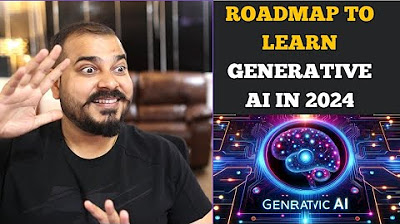A Beginner's Guide to Vector Embeddings
Summary
TLDRThis video introduces vector embeddings, essential for understanding generative AI. It explains how these embeddings convert complex data, like text and images, into numerical representations that computers can process. The video covers the creation of embeddings through advanced machine learning models, visualizing them in a 3D space, and storing them in specialized vector databases. Key applications are highlighted, including recommendation systems, search engines, chatbots, and fraud detection. Overall, the video showcases the growing importance and potential of vector embeddings in enhancing AI capabilities.
Takeaways
- 😀 Vector embeddings translate text, images, and videos into numerical formats that computers can understand.
- 🔍 Similarity between vector embeddings is measured by their proximity in a multi-dimensional space.
- 📺 Recommendation engines utilize vector embeddings to suggest related content based on user preferences.
- 🔄 Traditional feature engineering is labor-intensive; modern machine learning models automate the creation of vector embeddings.
- 📊 Popular models for generating text embeddings include Word2Vec, GloVe, and BERT, while CNNs like VGG and Inception are used for images.
- 🎨 RGB color representation can be conceptualized as vector embeddings in a three-dimensional space.
- 📦 Vector databases, such as Pinecone and Weaviate, optimize the storage and retrieval of vector embeddings for efficient querying.
- ❓ Vector systems can power applications like question and answer bots by finding relevant data based on user queries.
- ⚙️ Vector databases support robust data operations like create, read, update, and delete, alongside integration with other tools.
- 🚀 Emerging use cases for vector embeddings include search functionalities, chatbot assistance, product recommendations, and fraud detection.
Q & A
What are vector embeddings in machine learning?
-Vector embeddings are numerical representations of objects like text, images, or videos that allow computers to understand and process them. These representations are essentially lists of coordinates that describe the object in a multi-dimensional space.
Why are vector embeddings important in AI systems?
-Vector embeddings make AI systems more versatile by enabling them to incorporate external data. They transform different types of objects into a numerical format that machine learning models can easily process, allowing for better performance in tasks like recommendations and search.
How are vector embeddings created?
-Vector embeddings can be created by machine learning models that specialize in converting different types of objects, such as text or images, into vectors. Examples of such models include Word2Vec, GloVe, and BERT for text, and convolutional neural networks like VGG and Inception for images.
What is the concept of similarity in vector embeddings?
-The concept of similarity in vector embeddings refers to how close two vectors are in the multi-dimensional space. The closer the vectors are to each other, the more similar the objects they represent are. This is often measured using distance metrics like K-nearest neighbors.
Can you explain how vector embeddings work in recommendation systems?
-In recommendation systems, vector embeddings help suggest items that are similar to the ones the user is interested in. For example, if a user likes a particular product or show, the system can use vector embeddings to find other similar products or shows by measuring their proximity in the embedding space.
What are vector databases, and why are they important?
-Vector databases are specialized databases designed to store and manage vector embeddings efficiently. They allow quick searching, querying, and retrieval of related data. Examples include Pinecone and Weav8, which are optimized for storing embeddings and enabling scalable, high-performance searches.
How do vector embeddings contribute to search functionality?
-Vector embeddings improve search functionality by allowing search queries to be matched with closely related objects based on their vector similarity. For example, in text or image search, the system looks for vectors that are similar to the search query, providing more relevant results.
What role do vector embeddings play in fraud detection?
-In fraud detection, vector embeddings can help identify unusual patterns by clustering similar transactions or data. If a transaction or data point is far from the other embeddings in a cluster, it could indicate an anomaly, such as fraud.
How do machine learning models like BERT and Inception generate vector embeddings?
-Models like BERT generate vector embeddings by processing text data, such as words, sentences, or paragraphs, and converting them into numerical representations. Similarly, models like Inception generate vector embeddings for images by analyzing the visual features and converting them into vectors.
What are some practical use cases for vector embeddings beyond recommendations?
-Beyond recommendations, vector embeddings are used in various applications, including search engines, chatbots, question-answering systems, and fraud detection. They help improve accuracy and efficiency in these systems by enabling better data retrieval and analysis based on similarity.
Outlines

Cette section est réservée aux utilisateurs payants. Améliorez votre compte pour accéder à cette section.
Améliorer maintenantMindmap

Cette section est réservée aux utilisateurs payants. Améliorez votre compte pour accéder à cette section.
Améliorer maintenantKeywords

Cette section est réservée aux utilisateurs payants. Améliorez votre compte pour accéder à cette section.
Améliorer maintenantHighlights

Cette section est réservée aux utilisateurs payants. Améliorez votre compte pour accéder à cette section.
Améliorer maintenantTranscripts

Cette section est réservée aux utilisateurs payants. Améliorez votre compte pour accéder à cette section.
Améliorer maintenantVoir Plus de Vidéos Connexes

OpenAI Embeddings and Vector Databases Crash Course

1- Lets Learn About Langchain-What We Will Learn And Demo Projects

Roadmap to Learn Generative AI(LLM's) In 2024 With Free Videos And Materials- Krish Naik

Vector Databases simply explained! (Embeddings & Indexes)

Privacy-Friendly Applications with Ollama, Vector Functions, and LangChainJS by Pratim Bhosale

How does ChatGPT work? Explained by Deep-Fake Ryan Gosling.
5.0 / 5 (0 votes)
